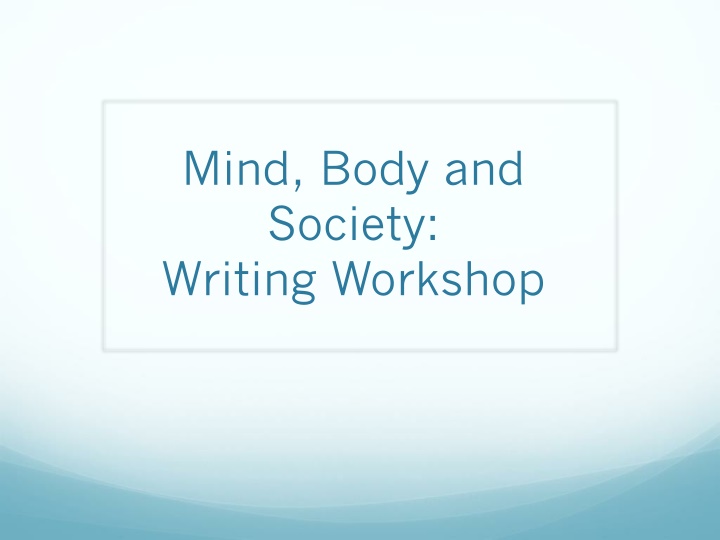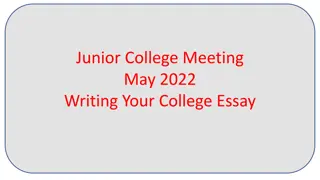Writing Workshop: Referencing Techniques and Essay Planning
This content provides guidance on referencing in academic writing, including footnotes and bibliography for books and articles, as well as an exercise to practice proper referencing. It also offers tips on planning an essay effectively, such as analyzing the essay title, identifying historical problems, and outlining main questions and sub-themes.
Download Presentation

Please find below an Image/Link to download the presentation.
The content on the website is provided AS IS for your information and personal use only. It may not be sold, licensed, or shared on other websites without obtaining consent from the author.If you encounter any issues during the download, it is possible that the publisher has removed the file from their server.
You are allowed to download the files provided on this website for personal or commercial use, subject to the condition that they are used lawfully. All files are the property of their respective owners.
The content on the website is provided AS IS for your information and personal use only. It may not be sold, licensed, or shared on other websites without obtaining consent from the author.
E N D
Presentation Transcript
Mind, Body and Society: Writing Workshop
REFERENCING: FOOTNOTES BOOKS: First citation: Author s full name, Full Title of Book (Place of publication, year of publication), page number(s). Eric Hobsbawm, Age of Extremes. The Short Twentieth Century, 1914-1991 (London, 1994), p. 67. Second and subsequent citations: Author s surname, Short Title, page number(s). Hobsbawm, Age of Extremes, pp. 352-54. ARTICLES: First citation: Author s full name, Full Title of Article , Journal Name, volume number (year), page number(s). Cultural Peter Bailey, Parasexuality and Glamour. The Victorian Barmaid as Prototype , Gender and History, 2 (1990), pp. 150-53. Second and subsequent citations: Author s surname, Short Title , page number(s) Bailey, Parasexuality and Glamour , p. 164.
REFERENCING: BIBLIOGRAPHY BOOKS: Author s last name, first name, Full Title (Place of Publication, Year). Hobsbawm, Eric, Age of Extremes. The Short Twentieth Century, 1914-1991 (London, 1994). ARTICLES: Author s last name, first name, Full Title of Article , Journal Name, volume number (year), page numbers of full article. Cultural Peter Bailey, Parasexuality and Glamour. The Victorian Barmaid as Prototype , Gender and History, 2 (1990), pp. 148-171. Note that bibliography form departs in a number of respects from footnote style. In particular, note that material in your bibliography is organised alphabetically by the author s surname. When referencing articles or chapters in edited volumes in your bibliography, cite the page numbers of the article or chapter as a whole - not just the particular pages you have cited in your footnotes.
REFERENCING EXERCISEFOOTNOTES 1.Francois Delaporte, Disease and Civilization: The Cholera in Paris, 1832 (Cambridge, 1986), pp. 37- 40. 1.Adrian Wilson, On the History of Disease Concepts: The Case of Pleurisy , History of Science, 38 (2000), p. 280. 1.Delaporte, Disease and Civilization, p. 112.
REFERENCING EXERCISEBIBLIOGRAPHY Delaporte, Francois, Disease and Civilization: The Cholera in Paris, 1832 (Cambridge, 1986). Wilson, Adrian, On the History of Disease Concepts: The Case of Pleurisy , History of Science, 38 (2000), pp. 271-319.
Planning an Essay First steps Read and analyse the essay title. Be as careful and thorough as possible, and answer a set of basic questions: What is the subject matter? What period shall I consider? Which geographic area? Then, write down your preliminary thoughts and ideas and try to identify the historical problem raised by the question. Produce a plan, highlighting your main questions and sub-themes.
How to organise your argument and structure your essay Introduction Introduce and present the subject matter in broad terms Identify and clarify the historical problem Situate your work in the context of the historiography Signpost your argument Take the reader through the process through which you will answer your question Setting up in many ways is the most important aspect of writing an essay
The Introduction: Take the reader for a walk As you are taking your reader on a walk, you first need to invite her/him, to let her/him know where you are both going to (introduce the subject matter). To capture her/his attention, her/his historical imagination, you need to make clear why the walk is worth her/his time and energy (raise the historical problem). Then show her/him the path you have decided to follow (signpost your argument)
The body of the essay Make sure that your overall analysis and each of your individual points is supported by evidence. Make sure your essay follows a logical order; that the succession of points, sections, and paragraphs derives from an intellectual logic. In other words, your essay should not be a mere catalogue of ideas but should present them in a reasoned and coherent way. You might want to use sub-headings to guide you as well as the reader.
References Provide full references following the style guide carefully. Reference every quote with a footnote. Provide a reference each time you draw ideas or evidence from a secondary OR primary source. Make sure you provide a full and well organised bibliography, separating primary and secondary sources.
Getting ready for the conclusion Re-read the essay to ensure that you have covered all the points you promised to tackle. Make sure you have answered the question. Read your essay out loud this weeds out awkward phrasing and repetition. Take your time writing a conclusion and make sure you summarise your main findings clearly and succinctly.























